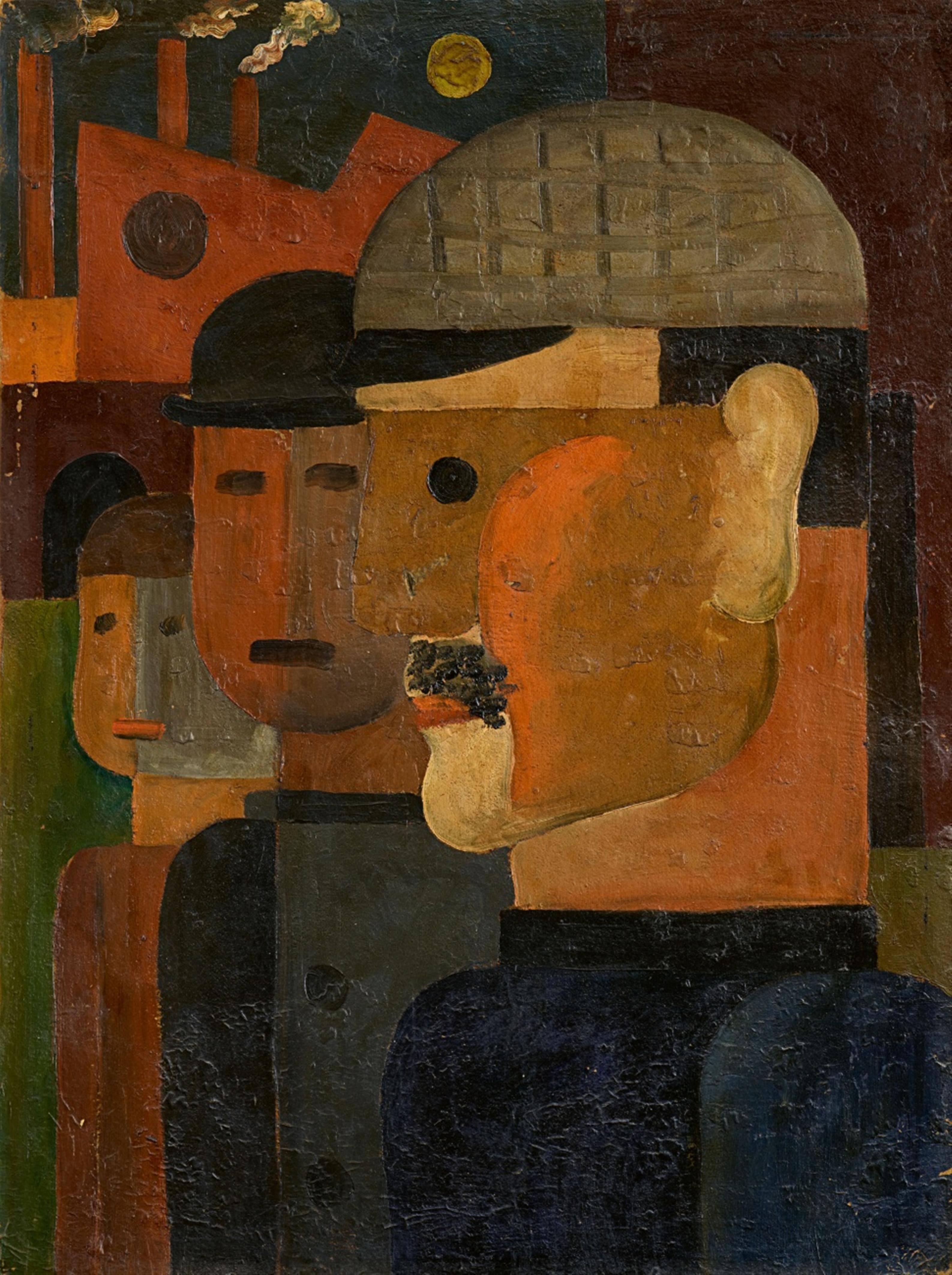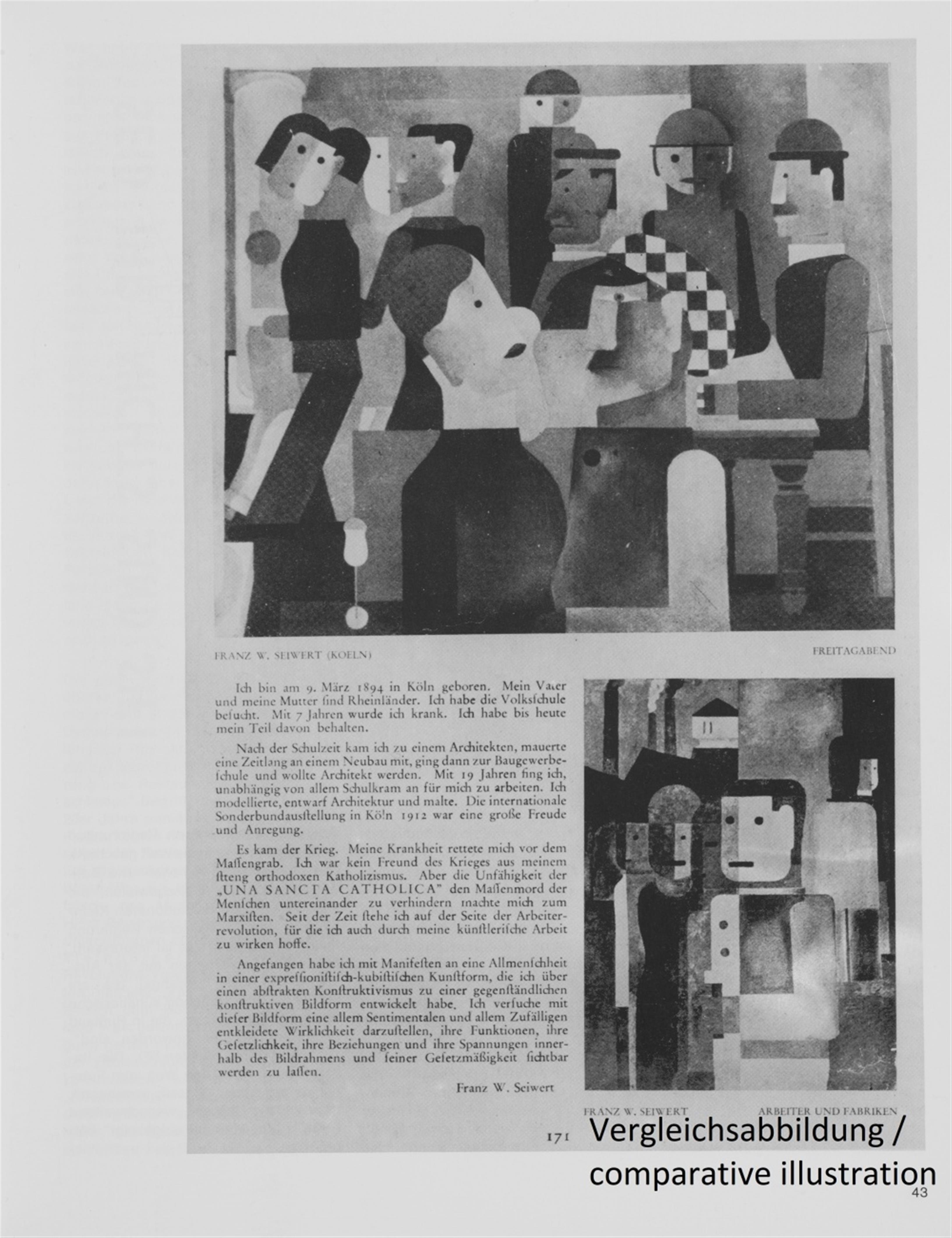Franz Wilhelm Seiwert
Drei Arbeiterköpfe
1926
Oil and canvas on thick artist's board 68.9 x 52 cm Framed. Monogrammed and dated 'FWS 26' (scratched into wet paint) upper margin to right of centre. - Verso inscribed "Jean Loosen" (Cologne stonemason and Seiwert's friend) in blue handwriting. - Partially with craquelure and smaller marginal age-related defects.
According to the date located next to the monogram, the “Drei Arbeiterköpfe” by Franz Wilhelm Seiwert, which were previously placed somewhat earlier in his oeuvre, have moved closer to an important work of 1927, “Freitagabend”, a painting which was formerly housed in the Wallraf-Richartz-Museum, was confiscated in 1933 and destroyed during a bombing raid (see comparative illus.). It is not just the profile type of the man with a moustache that can be found there. In the 1920s Seiwert developed a certain repertoire of formulaic motifs and constructive figurations which he knew how to modify and combine almost in the manner of stencils. Coupled with an emphatic two-dimensionality of the picture, these included the use of simplified and abbreviated forms employed to produce strong contrasts: circular curved forms, emphatic vertical and horizontal lines and staggered diagonals. These elements of geometric abstraction, the rigorously simplified contours, the elements drawn on to the heads and figures and their densely packed alternation in frontal and profile views are stylistic devices which originally derived from Seiwert's graphic work and his artistic and political propaganda. While efforts had already been made since 1919 to “create building blocks for a new visual language” - for example, Angelika Hoerle's linocuts for an “a b c Bilderbuch” (cf. “Angelikas Erbe”, in: Experiment Kalltalgemeinschaft, op. cit., p. 44) - the question of the reach and acceptance of the revolutionary art of the “Kölner Progressive” within society remained a constant theme that also left its mark in the form of articles in the journal “a-z” (1929-1933). In the medium of oil painting, Seiwert had been experimenting not just with the attained elements of a new pictorial idiom but also with painting techniques and supports since the middle of the decade as well as in the “Drei Arbeiterköpfe” of 1926. Seiwert's emphasis on materialities, on colours and tactile surfaces distinguishes him and situates his work in the midst of the international artistic avant-garde context of those years.
See further works by F.W. Seiwert in our Auction 1163 on 9 December 2020, lots 493-499.
Catalogue Raisonné
Bohnen 59 (there "Um 1924/25")
Certificate
We would like to thank Uli Bohnen, Eschweiler, for kind advice; with his certificate dated 30 October 2020
Provenance
Jean Loosen (probable first owner); Galerie Brockstedt, Hamburg; Collection Stanislaw Karol Kubicki, Berlin; since then in family possession
Literature
Reinhard Schilf (ed.), Experiment Kalltalgemeinschaft- Die Kölner Progressiven in Simonskall 1919-1921, Weilerswist 2008, cf. Angelikas Erbe, p. 44/45; cf. Lynette Roth, Handwerk oder "Das Werk der Hand", in: 1920-33, köln progressiv, seiwert-hoerle-arntz, Katalogbuch, Museum Ludwig, Cologne 2008, p. 70 f.
Exhibitions
Cologne 1978 (Kölnischer Kunstverein), Franz W. Seiwert 1894-1933, cat. no. 59 with full-page illus. p. 95 (two exhibition labels verso); Recklinghausen 1980 (Ruhrfestspiele), Aus Schacht und Hütte. Ein Jahrhundert Industriearbeit im Bild 1830-1930, cat. no. 162 with illus. (transport label on frame)




